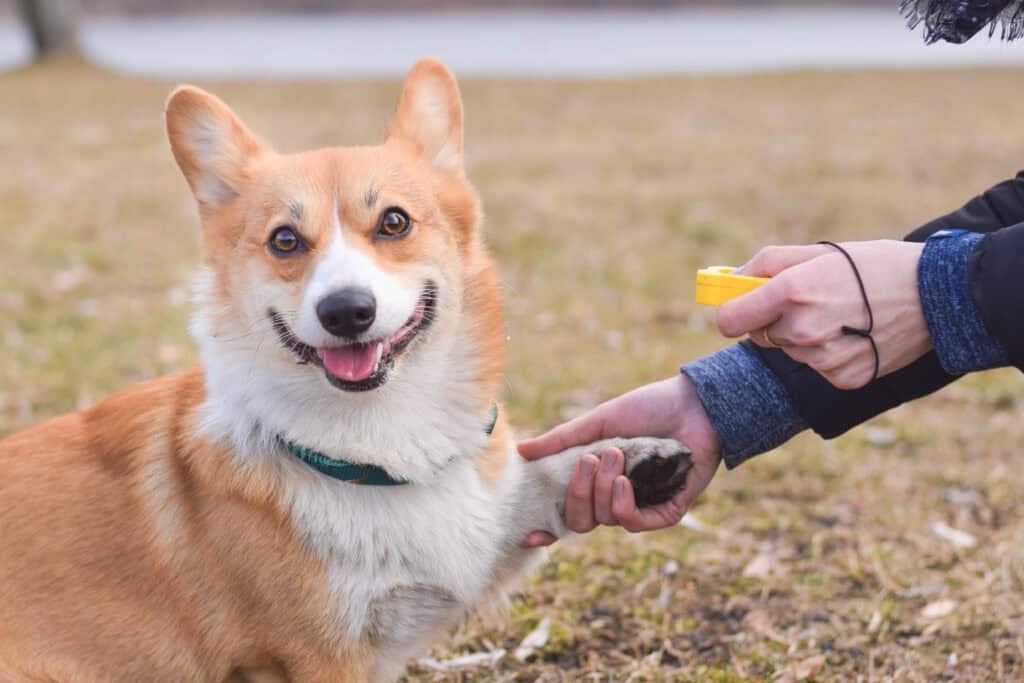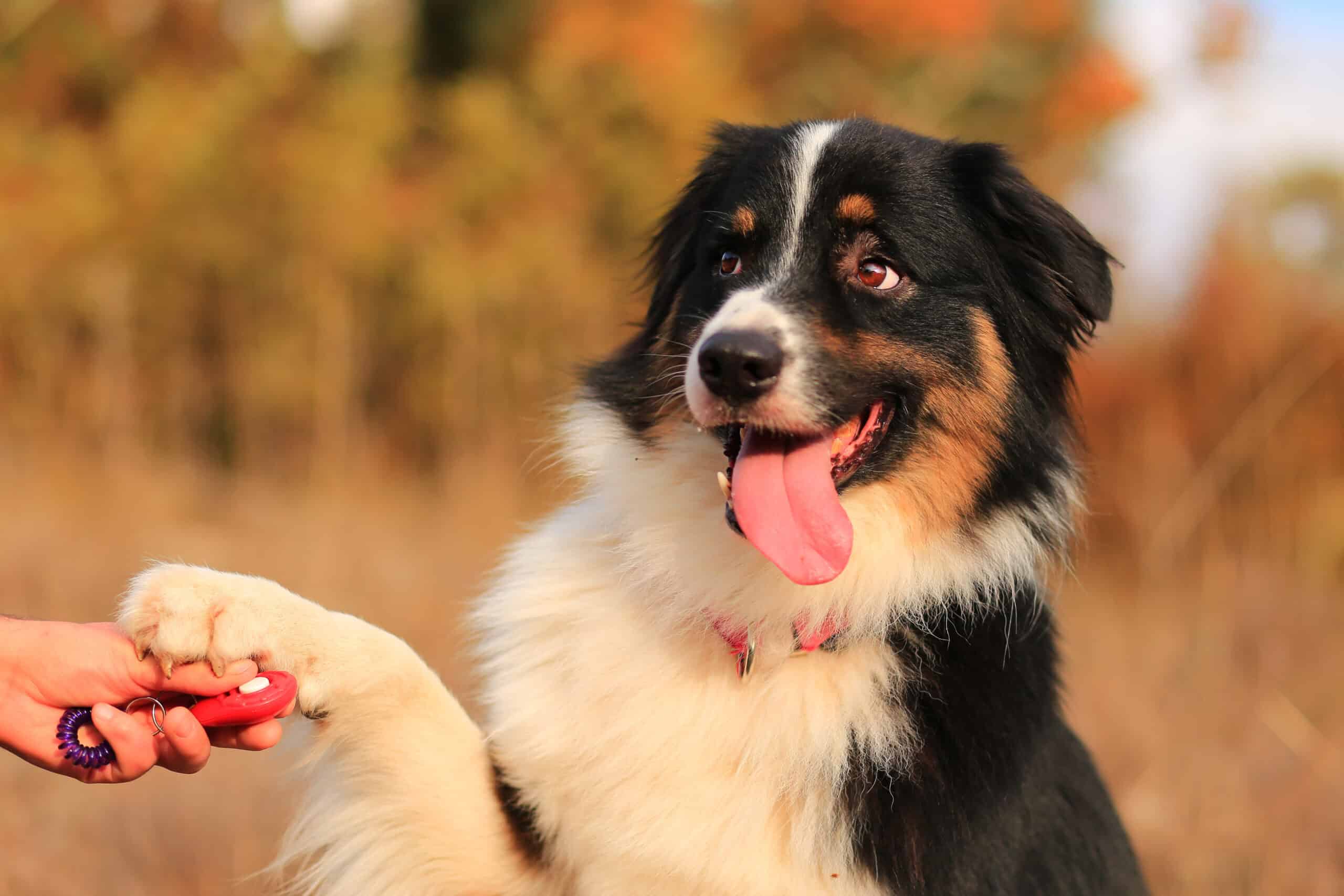If you have a dog, you have likely come across the term “clicker training” at some point. A popular tool within the positive reinforcement based and balanced training communities alike, the clicker was popularized as an effective dog training tool by the marine mammal trainer Karen Pryor in the 1980s. During this time, positive reinforcement based methods were still virtually unheard of in dog training, so the concept of applying a secondary reinforcer as a training tool was even more unconventional.
As more trainers began including clickers into their training regimens, it was recognized what a powerful tool they can be. This introduction was significant to the revolutionary changes experienced within the dog training industry – from a focus on punitive training techniques to positive reinforcement based methods. Maybe you have heard of clickers in an online video, book, or training class and are curious about how you can use them to reach your dog training goals. Perhaps you have even seen them being used in person or have used one yourself but want to understand how to optimize their use in your training. This article will discuss everything that you need to know about clicker training and how it can be used to transform your dog training.
What is a clicker?
So what exactly is a clicker? Physically, clickers often look like small rectangular objects containing either a button or thin brass or steel sheet on one side which can be pressed inwards to make a distinctive “clicking” sound. They come in a wide variety of colors, different shapes, and even different volumes. You can purchase clickers on keychains, wrist straps and lanyards. Basically, there is a clicker out there for every dog trainer and every dog.
A clicker works as a method of marking correct behaviors in the instant in which they occur with a highly consistent stimulus. This can be difficult to achieve using your voice alone, and can be even more difficult to accomplish using food or toy rewards – especially during shaping work or more complex training tasks.
Why does the clicker work?
It may appear to be a very simplistic tool – and you may be wondering how a small plastic box could help you teach your dog to locate target odors or retrieve drinks from your fridge – but the way that it works is actually quite complex.
The clicker is such a useful tool because it harnesses the power of two very powerful learning techniques.
- Classical conditioning. Most dog training utilizes operant conditioning, which at its most basic refers to “action equals consequence.” In more practical applications, this could be giving your dog a treat for sitting on cue, or removing a toy from a dog attempting to resource guard it. Classical conditioning, however, refers to the constant pairing of two stimuli in order to accomplish associative learning. Basically, the clicker becomes valuable through the process of pairing the “click” with something very desirable.
- Secondary reinforcer. Dog training with a clicker is effective because classical conditioning is such a powerful learning tool; however, clickers are also very effective because they serve as a secondary reinforcer. There are two basic types of reinforcers: primary and secondary.
Primary reinforcers describe a stimulus which is innately desirable. This means that a learner requires the stimulus to live and thrive, and does not need to be taught that it is valuable. Some common primary reinforcers used in dog trainers are food, toys, water and social interaction.
Secondary reinforcers, on the other hand, are stimuli which have been associatively paired with primary reinforcers and consequently become valuable to a learner. In other words, the learner is taught that the stimulus is valuable through classical conditioning. This may seem obscure, but it inadvertently occurs all the time in daily life. For instance, if your dog loves walks and every time you put a particular pair of shoes on you immediately proceed to take your dog for a walk, your shoes will become valuable. In this case, you will likely find that your dog’s behavior changes perhaps drastically the moment they see you put that pair of shoes on. If a dog chases delivery drivers up and down a fence multiple times per day and really enjoys this act because it releases dopamine and is very stimulating, the presence of a delivery driver will become reinforcing because they signify the presence of something valuable. The clicker functions particularly well as a secondary reinforcer because it is such a consistent stimulus and is also very easy to control.
Once a clicker is conditioned, it is used to mark correct or desirable behaviors. Since the process of conditioning is so powerful, it enables a human trainer to communicate to their dog that a behavior should be repeated. Provided that the primary reinforcer in which the clicker was paired with is valuable enough, most dogs will enthusiastically work for clicks which enables a trainer to mark very fast behaviors or precise behaviors which often differ subtly from other behaviors. If a clicker is used correctly in order to “shape” a complex desired response, it is possible to teach dogs to do incredible things such as tricks like retrieving drinks from the fridge, service dog tasks, detection work, or behaviors like the ones you see animal actors demonstrate on TV.
What are the benefits of using a clicker?
Clickers can certainly be used to mark simplistic behaviors taught via the luring method of training, such as “sit” or “lie down”. In these instances, the clicker is simply used to mark the exact moment in which the final desired behavioral response occurs. This can be used as a way to extend the duration of time bridging the behavior and the administration of a treat, or to help keep a dog enthusiastic when asking for multiple behaviors before a single primary reinforcer is provided. In obedience training, clickers can also be used as a “bridge” marker to help gain time on long-duration behaviors such as stay. In these instances, the clicker can help communicate to a dog that they are still doing the correct thing even though a primary reinforcer has not yet been provided.
Where clickers really shine is in the teaching of complex, multi-component behaviors. Oftentimes, these behaviors cannot be taught through luring, and it is nearly impossible to guide a dog through the process. In these instances, we must break a complex behavior into numerous small parts where a single initial behavior is built upon until the dog understands the entire process. Many service dog tasks are a good example of this: selective retrievals in mobility dogs, alerting and assistance in seizure alert dogs, and most guide dog tasks would not be easy to teach without using markers. Complex tricks are another good example, such as teaching dogs to do dance choreography or act out a series of behaviors for a movie. In these instances, minuscule, incremental behavioral changes are marked and rewarded until the behavioral response has formed something very precise.
Apart from the more comprehensive benefits of using a clicker to achieve dog training goals, clickers have other more specific advantages as well when comparing them to alternative marking tools such as vocal cues.
- Consistency. It can be difficult to maintain a perfectly consistent marker signal when using the human voice or a whistle. Provided a clicker is used as intended, it will always create the same sound, at the same frequency, for the same duration of time. This helps eliminate any potential confusion for your dog in addition to increasing the rate in which your dog is conditioned to the sound.
- Ease of use. The clicker is a very no-frills tool. There is only one potential button to press, and this button oftentimes consumes a significant portion of the clicker’s body. It is important to practice the timing of one’s clicks when first learning how to use a clicker, but using the clicker itself is typically very straightforward.
- Novelty. The sound of a clicker is incredibly unique. Most clickers also create an audible enough sound to immediately grab a dog’s attention even prior to the conditioning process. This sound remains novel in most environments, so there is little chance of a dog mistaking the sound for something else. The novel nature of this device is advantageous because dogs are unlikely to have any learning history associated with its sound, as well as the novelty triggering an innate curiosity in most dogs leading to accelerated learning.
- Portability. Clickers are very conveniently sized and easily fit inside training pouches, purses or pockets. Many clickers also include a wristband so they can easily be worn out in public and during training sessions.
Finally, the sound that a clicker makes is also brief yet very noticeable, making it ideal for use as a marker tool.

How to correctly use a clicker
The clicker is a very useful tool when used appropriately, and it can be transformative for one’s dog training practice. This being said, it can also be ineffective and frustrating when not used correctly. The following steps will teach you how to condition and use a clicker in the most effective way possible.
- Condition the stimulus. The first step in using a clicker is to condition your dog to the click. The conditioning process will look like a sped up version of the Pavlov’s Dogs experiment (where physiologist Ivan Pavlov discovered that dogs would begin salivating after hearing a sound which had previously preceded meals). In order to condition the clicker, you will click and then immediately feed your dog a treat. Repeat that numerous times throughout the day for multiple days. During this process, you will want to make sure that you select a high value food reward which can be quickly consumed by your dog. You will also want to ensure that you are administering the food immediately after the click occurs, and you do not want to ask your dog to perform any behaviors prior to the click occurring. It is imperative for your dog to understand that click = treat during this stage.
- Begin using the clicker as a secondary reinforcer. Once your dog is demonstrating noticeable enthusiasm after hearing the click, you can begin pairing the clicker with desired behavioral responses which your dog can already perform consistently. Typically this stage will include behaviors such as “sit,” “down,” or “come.” Regardless of which behaviors you choose to ask for, make sure that your dog knows them and will most likely respond correctly. As soon as your dog performs the behavior, click and immediately provide a treat. It is useful to spend approximately a week doing this prior to moving onto the next step.
- Teach new behaviors. Once your dog is adequately conditioned to respond to the clicker and understands that it signals a desirable behavioral response, you can begin using the clicker to teach new behaviors. You may want to select behaviors that you can lure through at this point in order to prevent potential frustration for your dog. During this stage, lure, click and reward if your dog performs the behavior correctly.
- Begin applying the clicker to simple shaping exercises. If you plan to use your clicker to teach your dog complex, multicomponent behaviors, now is the time to begin teaching your dog about shaping. Set them up for success by making it easy for your dog to engage in a behavior which can eventually be shaped into the behavior you want. For instance, if you are trying to teach your dog to ring a bell, you will get your dog’s attention and then place the bell on the ground right by your dog. They will likely sniff the bell out of curiosity, allowing you to reward the intentional movement toward the correct object.
In conclusion
If you feel that you’ve plateaued in your dog training and want to make progress, or if you want to revolutionize your dog training goals through shaping, consider implementing the clicker in your practice. A valuable tool for the many reasons outlined above, a clicker will open up a vibrant new channel of communication with your dog while minimizing confusion and helping to keep them enthusiastic about training.
Do you have questions about how to use the clicker? Our team of professional dog trainers at Greenside Canine is here to help. You can contact us at (317) 558-9145 or by emailing train@greensidecanine.com.

